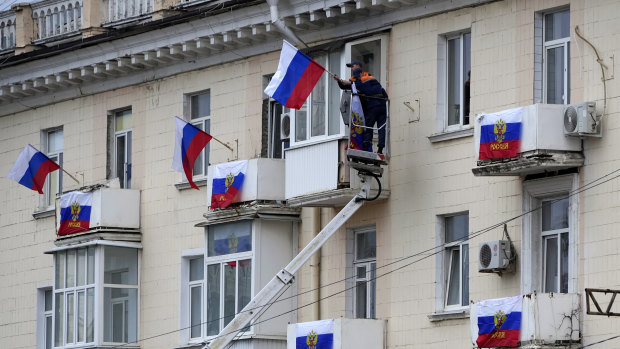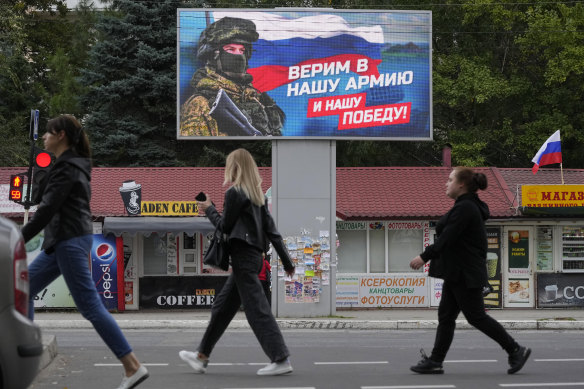This was published 2 years ago
Moscow wins big in sham elections in Ukraine’s occupied regions
By Mark Trevelyan
London: Russian-installed officials in occupied regions of Ukraine reported huge majorities on Tuesday in favour of becoming part of Russia after five days of voting in so-called referendums that Kyiv and the West denounced as a sham.
Hastily arranged votes had taken place in four areas - the eastern regions of Donetsk and Luhansk, and to the south Zaporizhzhia and Kherson - that make up about 15 per cent of Ukrainian territory.

Workers hang Russian flags at an apartment building in Luhansk, Luhansk People’s Republic controlled by Russia-backed separatists, eastern Ukraine.Credit: AP
Luhansk authorities said 98.5 per cent of people there had voted to join Russia, based on 69 per cent of ballots counted. In Zaporizhzhia, a Russian-appointed official put the figure at 93.1 per cent with the count now completed. while in Kherson the “yes” vote was running at more than 87 per cent, according to the head of the voting committee.
Russia’s Tass news agency said 93.95 per cent in Donetsk region had voted in favour, with nearly 32 per cent of the ballots counted.
Within the occupied territories, Russian-installed officials took ballot boxes from house to house in what Ukraine and the West said was an illegitimate, coercive exercise to create a legal pretext for Russia to annex the four regions.

People walk past a billboard displaying a soldier and a Russian flag and reading ‘We believe in our army and our victory’ in Luhansk, Luhansk People’s Republic controlled by Russia-backed separatists, eastern Ukraine.Credit: AP
Russian President Vladimir Putin could then portray any Ukrainian attempt to recapture them as an attack on Russia itself. He said last week he was willing to use nuclear weapons to defend the “territorial integrity” of Russia.
Displaced people from the four regions were able to cast votes in Russia, where state news agency RIA said early counts showed numbers in excess of 96 per cent in favour of coming under Moscow’s rule.
Ukraine has repeatedly warned that Russian annexation of territories would destroy any chance of peace talks, seven months after Russia invaded its neighbour. It says Ukrainians who helped Russia organise the votes will face treason charges.
Ukrainian Foreign Minister Dmytro Kuleba urged the European Union to impose further economic sanctions on Russia to punish it for staging the votes, which he said would not change Ukraine’s actions on the battlefield.
The votes mirrored a referendum in Crimea after Russia’s seizure of the southern peninsula from Ukraine in 2014, when Crimea’s leaders declared a 97 per cent vote to secede from Ukraine and join Russia.
Putin said on state TV on Tuesday that the votes were designed to protect people from what he has called the persecution of ethnic Russians and Russian-speakers by Ukraine, something the Kyiv government has denied.
“Saving people in all the territories where this referendum is being held is at the top of our minds and the focus of attention of our entire society and country,” he said.
Moscow has acted in recent months to “Russify” areas under its control, including by issuing people with Russian passports and rewriting school curriculums.
The referendums were hurriedly brought forward this month after Ukraine seized the momentum on the battlefield by routing Russian forces in the northeastern Kharkiv region.
Valentina Matviyenko, head of the upper house of the Russian parliament, said that if the vote results were favourable, it could consider the incorporation of the four regions on October 4, three days before Putin celebrates his 70th birthday.
Meanwhile, Russia continues to see an exodus of men who are going abroad to avoid the recently announced mobilisation of its military service to fight in Ukraine.
Over 194,000 Russian nationals have fled to neighbouring Georgia, Kazakhstan and Finland — most often by car, bicycle or on foot — in the week since President Vladimir Putin announced a partial mobilisation of reservists.
The Interior Ministry of Georgia said over 53,000 Russians have entered the country since last week, while Interior Ministry officials in Kazakhstan said 98,000 crossed into that nation.
The Finnish Border Guard agency said over 43,000 arrived in the same period. Media reports also said another 3000 Russians entered Mongolia, which also shares a border with the country.
Reuters, AP
Get a note directly from our foreign correspondents on what’s making headlines around the world. Sign up for the weekly What in the World newsletter here.